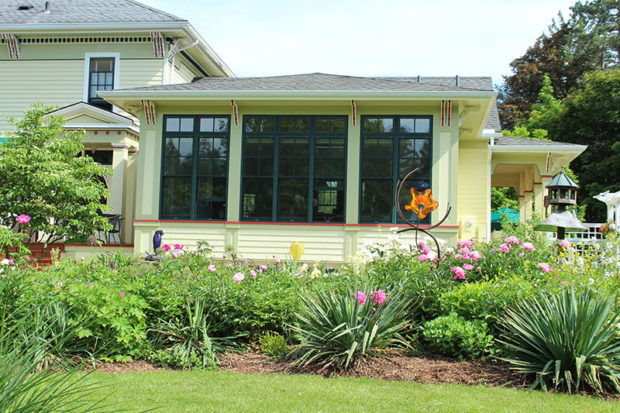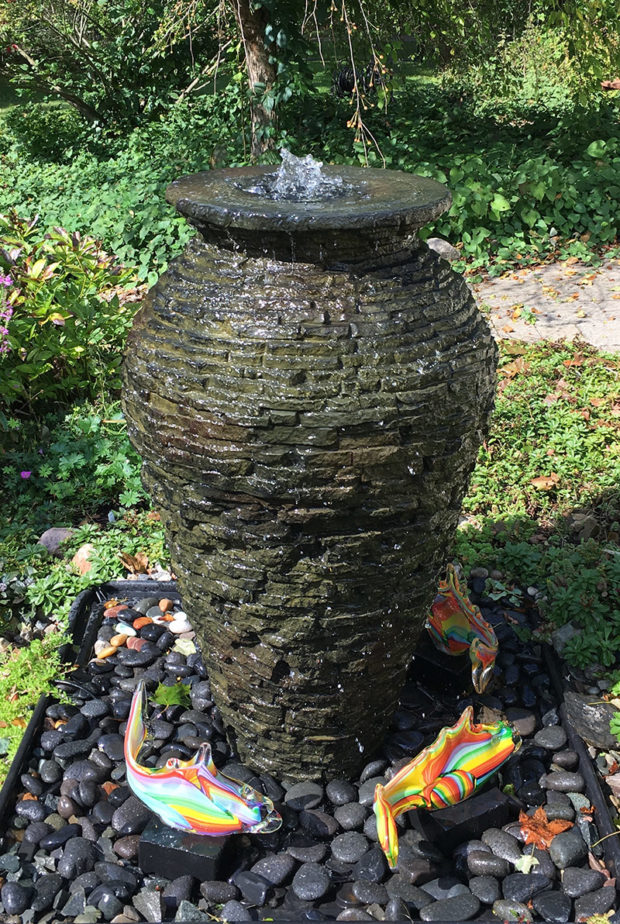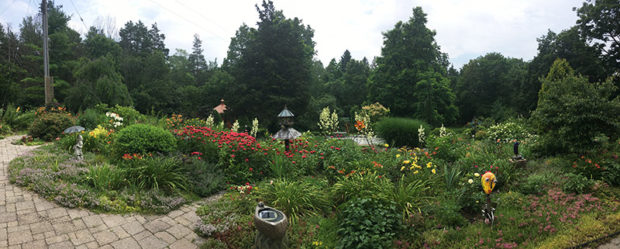By Christine Jamieson
When I first started to garden, I wanted everything: a pond; a fountain with plumes of water flashing in the sun; arches covered with fragrant roses, honeysuckle and clematis; pleached allees made of hornbeam; an arboretum (albeit a miniature one); garden “rooms”; a rockery; trough garden; alpine house; fruit trees; plus every perennial that would grow in Michigan and many that would not. No vegetables though, I couldnʼt deal with the glut. At one point I was ready to order two silver-leaved senecios (variety ʻSunshineʼ) and plant them in gigantic tubs at my front door, but even I was daunted by the difficulties of housing them over the winter in our small ranch. Garden features like sculpture and benches always appealed to me, but my primary interest was, and is, the plants.
An early entry in my garden journal reads: “Had a stunning idea in the middle of the night to make a dry pool where the small circular bed of tulips is. I am going to put a grass in the middle, either plume grass (Erianthus ravennae) or a thinner one (Miscanthus sinensis ʻGracillimusʼ perhaps), to be a fountain. My water is going to be lamb’s ears (Stachys byzantina ʻSilver Carpetʼ), and Iʼm going to edge it with two layers of those flat stones and drape creeping phlox over the edge to give foliage contrast.”
Initially, I started in a small way with a winter garden bed in front of the family room window and filled it with Japanese holly, American holly, leucothoe, bulbs and hellebores. After that I never looked back. “Youʼll be sorry,” my mother said to me one day as I was digging up yet more lawn—and she was right. Eventually I had no time for proper maintenance, which just goes to show we should always listen to our mothers.
I decided to create a large “room” edged with evergreens in the middle of the lawn. I tried yews, but they were so slow that I moved them to the back of the yard where they eventually grew into a splendid hedge. I finally settled for roses—tough, northern-grown ones. By now I was so enthusiastic that I joined the Lily Society, the American Horticultural Society, the Primrose, Daffodil and Rose Societies, the English Hardy Plant Society, and subscribed to several gardening magazines.
My first passion was bulbs—I planted several thousand the first year, never again, but it was worth it the following spring. I had snowflakes (both the spring and summer leucojums), several varieties of hardy cyclamen, hardy gladioli, real English bluebells, fritillaries, plus the more ordinary tulips, daffodils and crocus, and all sorts of alliums. I fell in love with Oriental poppies and Siberian, English, Dutch, Japanese and Louisiana iris, lilies, and then dwarf evergreens. I remember searching for Christopher Lloydʼs favorite arborvitae (Thuja occidentalis ʻRheingoldʼ) and then lo and behold the following year gardening had become the number one leisure pastime in the country and it turned up at a local nursery.
Of course it wasn’t long before I was trying to grow difficult stuff. One evening I was at a party full of avid gardeners and my friend from the Lily Society said, “Guess what Iʼm trying to grow?” “Himalayan blue poppy,” I replied promptly. “How did you know?” he asked stunned. I knew because it is an irresistible flower and I had just been having a go myself, but it hates Michigan weather and who can blame it?
One year I planted green flowers. “Ugh, green flowers,” my rude friends said and then fell about laughing, but there was something so exotic about bells of Ireland (Moluccella laevis), stinking hellebore (Helleborus foetidus), green coral bells, green zinnias, and the odd-looking snake’s head iris (Iris tuberosa) with its black velvet and green petals. Black was another color I liked—except in tulips—and when my first black pansy flowered I called my friend and she rushed over to admire it. What she actually said was that she had been expecting something the size of a dinner plate, whereas this was only small and very disappointing. Not to me though—I loved its soft kitten face with the yellow eye at the center; it grew prolifically and re-seeded itself year after year.
After this I entered my snob stage—the more minuscule and unusual the plant, the better. I tried all sorts of saxifrages and other rock plants, particularly rock roses (Helianthemum), which are very beautiful with their bright flowers and delicate foliage. That didnʼt last too long—eventually I preferred stuff that would grow well and could be seen, particularly tree and herbaceous peonies, Japanese anemones, hostas and pinks (Dianthus). I also love flat-faced flowers like yarrow and sedum. Yellow is a favorite color and it looks lovely combined with soft, dusty pink as well as the more usual blue.
Eventually I bought some fruit trees—apples that George Washington and Thomas Jefferson had grown, an old apricot variety, a couple of peaches, a cherry and a wonderful gooseberry called ʻPoorman.ʼ My piece de resistance in fruit trees was a Smyrna quince with golden fruit the shape of a gigantic pear, but covered in a soft downy skin. Its flesh can be made into a lovely pink preserve which tastes rather odd, but is eaten with meat in the Middle East.
I used to be rather scathing about annuals but now I rather like them—so cheap and cheerful and utterly reliable. One plant I can do without is devil’s trumpets (Datura); for some reason I find it incredibly sinister-looking.
However, thatʼs my taste, and what makes gardening such fun is that you can do whatever you want on your own patch of land. At the moment I am into container gardens. I found two marvelous copper preserving pans in a junk shop and filled them with bulbs for spring and annuals for the summer. I put all kinds of pots on the patio and am trying all sorts of things in them, from geraniums to ladyʼs mantle (Alchemilla mollis), lilies and dwarf evergreens. One day I discovered an abandoned cast iron bath tub in a derelict house which I desperately wanted to make into a trough garden, but I couldn’t work out how to get it home, not even with the help of the family.
So for what it’s worth, my advice is to plant what you like, dream dreams, and enjoy yourself. I wonder if I should buy a greenhouse and grow orchids…





